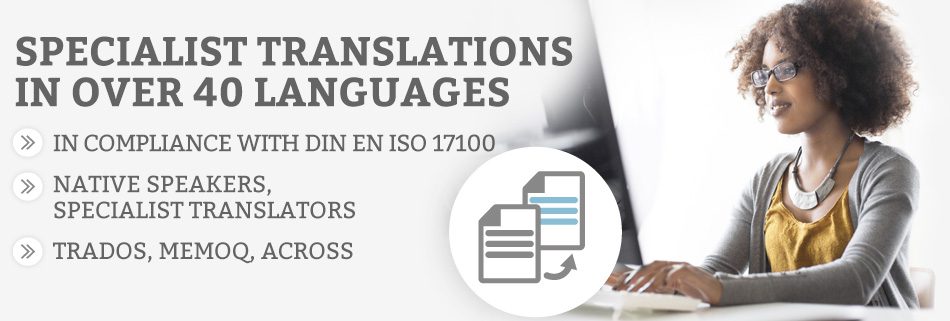When we say we speak the language of our customers, then we mean it. Not just one, two or ten, but more than 40! Therefore, we can help you in all major language combinations and are able to support you with more exotic jobs – for example projects in Zulu or Malayalam.
A multitude of languages – more than 40 languages and over 1,500 language combinations.
No matter what type of translation you require, we are your competent partner when it comes to translations.
We offer translations for the following languages:
Arabic, Bulgarian, Catalan, Chinese, Croatian, Czech, Danish, Dutch, English, Estonian, Finish, French, German, Georgian, Greek, Hebrew, Hindi, Hungarian, Indonesian, Italian, Japanese, Korean, Latvian, Lithuanian, Luxembourgish, Maltese, Macedonian, Norwegian, Persian, Polish, Portuguese, Romanian, Russian, Swedish, Serbian, Slovakian, Slovenian, Spanish, Tagalog, Thai, Turkish, Ukrainian, Vietnamese, Urdu.
We offer the following order types:
Simple translation
![]()
![]()
![]()
![]()
![]()
![]()
![]()
Our project managers view all texts and documents to be translated, prepare these for a professional translation and choose the appropriate specialist translator for your translation.
After delivery of the translation a quality control is performed and the translation is delivered to you.
Translation including proofreading
![]()
![]()
![]()
![]()
![]()
![]()
![]()
![]()
![]()
We strongly recommend an additional proofreading by a second translator for translations intended for publication or print.
In addition to the services of the “Simple translation”, a second translator checks all translations for spelling and grammar, correct hyphenation and proper setting of paragraphs to ensure that the translation can go to print or be published without further checks required.
Translation including editing
![]()
![]()
![]()
![]()
![]()
![]()
![]()
![]()
![]()
![]()
![]()
In this order type, a second specialist translator checks whether the content and all specialist terms have been translated and applied correctly, in addition to spelling, grammar, syntax and correct setting of paragraphs. Furthermore, the style of the translation is adapted according to the intended purpose of the texts.
The processing of translations at Leginda
Not only small companies often assume that professional translations represent an unnecessary cost factor – especially taking into account that almost everyone speaks a foreign language nowadays. However, this is not the same than a professional translation, especially a translation that has been prepared according to DIN EN 15038. Unfortunately, this is often only noticed when a business deal fell through as a result of a poor translation or when unnecessary further inquiries are received.
In order to deliver a professional translation, one first needs to find a translator, who has the appropriate technical skills and knows the subject matter well – we will find this qualified translator for you in our global network. Our translations are prepared in accordance with DIN EN 15038 and therefore the required qualifications are automatically guaranteed. In professional translation processes, usually mother-tongue speakers translate from the foreign language into their mother-tongue – never the other way round. You might have excellent skills in a foreign language, but this will never compete with a mother-tongue speaker. Our professionalism is also demonstrated by the use of our own programmed translation management systems in addition to modern translation tools such as Trados, MemQ and Across. These tools support the translation work particularly in comprehensive texts with many repetitions and ensure a consistent terminology, where applicable (e.g. technical documents or operating instructions). These programs are also applied for consistent terminology in new editions, updates or ongoing publications.
Certified translations of references or certificates, however, require a great deal of careful manual labour, as the appearance of the translation must be similar to the original. Also, advertising and marketing texts which need to be translated, require a lot “brain work”, which no artificial intelligence can provide. In this case, creativity and wit is essential – and a profound knowledge of the cultural environment the text is intended for.
Once the translator has checked the translation, the text is again checked in a proofreading/editing process. Here, the DIN EN 15038 applies once more – the proofreader/editor must have the same experience in the relevant subject area than the translator. The proofreader/editor thoroughly compares the source and target text and recommends corrections, which are not only limited to contextual errors, but can also include style and expression.
This way, we can guarantee the high level of quality of our translations. A translation is good, when the addressee correctly understands the context and does not even notice that the text is a translation.






